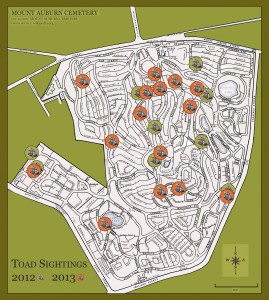Counting the Toads to Success
 In 2011, citizen-scientist Joe Martinez (New England Wildlife Center’s outreach educator) and Watertown Conservation Commission member Patrick Fairbairn, proposed a translocation of American toads, gray treefrogs, and spring peepers to Mount Auburn Cemetery grounds.
In 2011, citizen-scientist Joe Martinez (New England Wildlife Center’s outreach educator) and Watertown Conservation Commission member Patrick Fairbairn, proposed a translocation of American toads, gray treefrogs, and spring peepers to Mount Auburn Cemetery grounds.
Joe released over 4,000 tadpoles (Toads for Mount Auburn) into the vernal pool at Consecration Dell over a two year period that began in 2011. The success of this translocation effort has since been evaluated by counting toads, an effort that has been accomplished with assistance from Mount Auburn’s grounds crew and Conservationist Paul Kwiatkowski.
American Toad: An Introduction
The American Toad is a native amphibian in the eastern United States. It will mate and lay eggs in wet areas. Tadpoles will hatch from the eggs, emerge from the water as toadlets, and disperse onto the land to continue their metamorphosis until they become adult toads. The American toad can reach up to four inches in length in adulthood. Compared to frogs, toads:
* are found away from water bodies while the frogs will be in or next to water
* are brown in color while the frogs are green
* have warty skin while the frogs have smooth skin
* hop short distances while the frogs jump, usually directly into water
Reintroduction Project
In March of 2014, Joe presented an update, as may be seen from the map above, the metamorphosed toadlets leaving the Dell Pond have been dispersing throughout the cemetery. Green circles indicate juvenile toads found in 2012 and red circles indicate ones found in 2013. The observations were recorded primarily by the cemetery grounds crew during the course of their regular duties. One should bear in mind that these are simply sightings. They may all be different animals or, in some cases, the same animal may be seen more than once in the same general location. It is worth noting that the toads are growing; in 2012 most of the observed animals were the size of a quarter or less while in 2013 most of the observed animals were the size of a quarter or larger.
That they are being found in so many areas indicates that there is good habitat for young toads throughout the cemetery. That so many seem to be found in the north-central part of the cemetery is probably due to more cemetery staff moving through and working in that region. A toad in that area is therefore more likely to be seen.
If you see one, please email Paul Kwiatkowski with the following information:
• Where in Mount Auburn it was located (example, Birch Gardens)
• Size (example, as big as a quarter)
• Habitat (example, under a water spigot)
Also, please don’t pick them up. If you have bug spray on your hands, it will kill them. Thank you for being part of this success story.
Leave a Reply